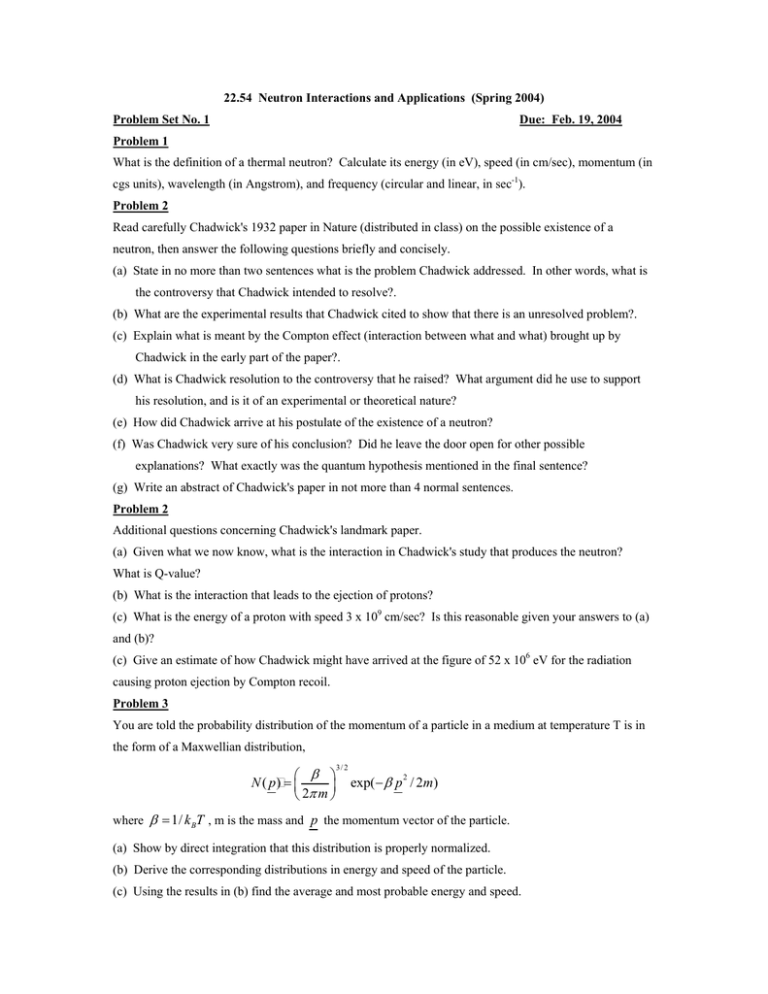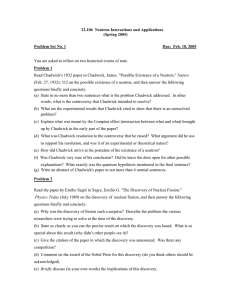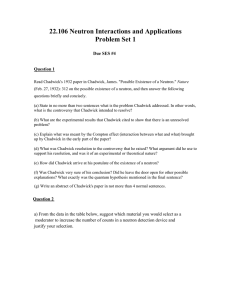22.54 Neutron Interactions and Applications (Spring 2004) Problem 1
advertisement

22.54 Neutron Interactions and Applications (Spring 2004) Due: Feb. 19, 2004 Problem Set No. 1 Problem 1 What is the definition of a thermal neutron? Calculate its energy (in eV), speed (in cm/sec), momentum (in cgs units), wavelength (in Angstrom), and frequency (circular and linear, in sec-1). Problem 2 Read carefully Chadwick's 1932 paper in Nature (distributed in class) on the possible existence of a neutron, then answer the following questions briefly and concisely. (a) State in no more than two sentences what is the problem Chadwick addressed. In other words, what is the controversy that Chadwick intended to resolve?. (b) What are the experimental results that Chadwick cited to show that there is an unresolved problem?. (c) Explain what is meant by the Compton effect (interaction between what and what) brought up by Chadwick in the early part of the paper?. (d) What is Chadwick resolution to the controversy that he raised? What argument did he use to support his resolution, and is it of an experimental or theoretical nature? (e) How did Chadwick arrive at his postulate of the existence of a neutron? (f) Was Chadwick very sure of his conclusion? Did he leave the door open for other possible explanations? What exactly was the quantum hypothesis mentioned in the final sentence? (g) Write an abstract of Chadwick's paper in not more than 4 normal sentences. Problem 2 Additional questions concerning Chadwick's landmark paper. (a) Given what we now know, what is the interaction in Chadwick's study that produces the neutron? What is Q-value? (b) What is the interaction that leads to the ejection of protons? (c) What is the energy of a proton with speed 3 x 109 cm/sec? Is this reasonable given your answers to (a) and (b)? (c) Give an estimate of how Chadwick might have arrived at the figure of 52 x 106 eV for the radiation causing proton ejection by Compton recoil. Problem 3 You are told the probability distribution of the momentum of a particle in a medium at temperature T is in the form of a Maxwellian distribution, β N( p) = 2π m 3/ 2 exp(− β p / 2m) 2 where β = 1/ k BT , m is the mass and p the momentum vector of the particle. (a) Show by direct integration that this distribution is properly normalized. (b) Derive the corresponding distributions in energy and speed of the particle. (c) Using the results in (b) find the average and most probable energy and speed.




